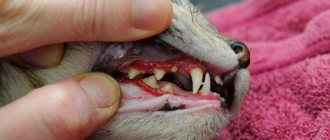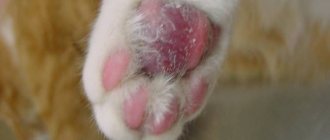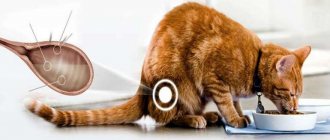Save article:
Calcivirosis in cats is considered a serious viral disease that is widespread. The disease affects the respiratory system. Complications of the disease can include pneumonia and arthritis. The tongue, mouth and nose are also often affected.
The virus is transmitted mainly through contact by sneezing from a sick cat to a healthy one. The disease is insidious: sometimes it hides and goes into the carrier stage, but stress manifests it again. To protect against calcivirus, vaccination can be performed, but it will not provide 100% protection, but will only alleviate the symptoms of the disease.
Causes of calcivirus infection
There are four strains of the pathogen worldwide. If the cat is infected, the disease will manifest itself after 5 days, which is the incubation period of calcivirosis.
It is easy to catch the infection without direct contact with an infected animal: if the pet sniffs the feces left by the carrier, or rolls around in the grass on which the carrier’s secretions are preserved, the virus enters the body.
Calcivirus spreads by airborne droplets - the radius of the virus is at least a meter from the carrier or source. If the virus gets on human skin, hair or clothing, it is viable for up to 5 days. This poses a danger to cats that do not leave the apartment.
Any secretion, including saliva, becomes a route of infection. When the pet recovers, it will be a source of infection for other cats for two months. Sometimes carrier status lasts a lifetime.
Since signs may not manifest themselves externally, you should be more careful when visiting cat shows and monitor your pet’s health after them.
Squamous cell carcinoma
Glossitis in squamous cell carcinoma
Malignant neoplasms in the mouth develop in cats older than 5 years. The occurrence of a tumor is facilitated by congenital predisposition, papillomatosis, and immunodeficiency states.
In addition to ulceration in the mouth cavity, the following signs of cancer are observed:
- halitosis;
- exhaustion;
- diarrhea and vomiting;
- difficulty defecating;
- painful urination;
- lameness;
- intermittent breathing.
The diagnosis is established by clinical signs, standard blood analysis and biochemistry, ultrasound, x-ray, and histological examination of the biopsy specimen.
The treatment strategy is developing in the following directions:
- radiation therapy;
- chemotherapy;
- use of immunomodulators;
- surgical removal.
The prognosis for treatment ranges from questionable to unfavorable.
Symptoms of calcivirosis in cats
global $ads_google;
//data-ad-slot=”2475549904″ $ads_google = empty($ads_google) ? false : true; ?> if ($ads_google == false) {?> $ads_google = true; ?> } ?> The course of calcivirosis in cats occurs in an acute form, the symptoms are often pronounced. Sometimes there is a latent form of the disease, characteristic of cats with strong immunity or with vaccination against this pathogen. In this case, symptoms may be subtle or absent.
Characteristic signs of the disease include:
- hyperthermia up to 40.5°C. The fever may last three days;
- nasal discharge that is clear at first. After some time, the discharge becomes serous, profuse and has a distinct foul odor;
- discharge from the eyes, which is also initially transparent and then becomes serous;
- profuse drooling;
- covering the tongue, lips, palate, and nose with numerous ulcers filled with fluid. The cat suffers from ulcers, tries to cough, and chews food with caution. Sometimes it seems that the animal simply choked. Inflammation of the gums is noticeable, they look swollen, pale or, conversely, red. Then the blisters will burst, but the wounds will bleed and hurt for a long time;
- putrid odor from the mouth;
- poor appetite;
- apathy and lethargy.
Often diarrhea is replaced by constipation, and at the beginning of the disease there is a single vomiting. A kitten's symptoms are no different from those of an adult cat.
Since the disease affects the respiratory system, the cat begins to cough and sneeze. Wheezing and shortness of breath appear. If the disease is severe, pneumonia, bronchitis or pulmonary edema develops.
The virus can enter the brain: after all the symptoms, convulsions are added, there is a noticeable deterioration in coordination of movements, gait, aggression and unreasonable fear appear.
In chronic calcivirosis, the course is asymptomatic with minor discharge from the nose and eyes, lethargy and apathy are possible. With the first stress, the disease becomes acute.
Symptoms of the disease
Cat owners should know the main symptoms of the disease, which can be used to suspect this oral disease in their animal. Each type of stomatitis has its own characteristic signs; we list the main ones.
10 signs of stomatitis
- The cat washes itself frequently and rubs its mouth vigorously as if something is bothering it.
- Increased salivation appears.
- The animal is thirsty. The cat drinks all the time.
- Appetite drops. The pet refuses its favorite treats.
- The lymph nodes in the lower jaw are enlarged.
- An unpleasant odor appears from the oral cavity.
- Hyperthermia. Body temperature rises.
- The cat sleeps a lot, becomes lethargic, and refuses active games.
- Saliva turns pink.
- Pus is released. Ulcers form in the mouth.
Important!
If you find signs of pathology in your pet, you must immediately show the animal to a specialist who knows what stomatitis looks like in a cat.
Treatment of feline calcivirosis
Calcivirosis in cats can be confused with gingivitis, panleukopenia, herpes or rabies. To make an accurate diagnosis, an examination by a veterinarian and tests to identify the pathogen are required.
Treatment for calcivirosis is prescribed immediately: you need to remove the symptoms of the disease using a broad-spectrum antibiotic. In addition, you need to boost your pet’s immunity with stimulants and vitamins. If there is a threat of dehydration and exhaustion, the cat requires the introduction of a nutrient solution.
Care for the organs of vision and breathing is required: the nose and eyes must be cleared of secretions using saline solution. The oral cavity needs sanitation.
If there is visible improvement, treatment is not stopped! After a couple of days, the cat may seem healthy, but the owner, not seeing any signs of the disease, stops giving injections, which threatens a serious relapse with all the consequences.
Calcivirus has a depressing effect on cats, so the treatment process must be carried out cleanly: the bedding is changed daily, and the room allocated for keeping a sick pet is ventilated as often as possible. The disease is not dangerous to humans, but it is easy for other cats in the house to become infected.
Medicines for calcivirosis
If the cat has been suffering from the disease for a long time, then lack of treatment can lead to its death. The disease is dangerous for those kittens that no longer receive maternal antibodies.
If the condition is severe, the owner is not able to provide the necessary assistance, so the cat is taken to the clinic, where veterinarians will take professional care of it.
If the cat is in a tolerable condition, they are nursed at home: force-feeding with soft and nutritious food in the form of pates is used. If the pet is dehydrated, solutions of sodium chloride, ringer, and glucose must be administered using a subcutaneous drip. The dose of the drug is calculated depending on the body weight and physical condition of the animal (5-20 ml per day). Inject the solution into the withers.
If an animal has a temperature, you should study means and ways to lower or increase it as necessary.
Drops based on Ciprofloxacin are instilled into the nose. The oral cavity is treated with chamomile decoction.
Causes of stomatitis in cats and kittens
The main causes of gum inflammation in cats include mechanical damage (trauma) to the oral cavity from bones or sharp objects, and poor hygiene.
The risk of infection will be higher if the food temperature is not observed when feeding your pet: too cold or too hot.
Another reason is the accidental ingestion of medications intended for external treatment. For example, if you apply flea ointment incorrectly, your cat may accidentally lick it with her tongue. And this way it gets inside the body.
Primary stomatitis in a cat can occur due to irritation of the mucous membrane, with the development of inflammation of the oral cavity caused by mechanical or thermal factors. Secondary stomatitis occurs due to a number of other diseases - gastrointestinal pathologies, all types of poisoning.
The disease itself may appear due to the presence of more serious diseases, such as:
- flu;
- lung disease;
- leukemia;
- immunodeficiency virus in cats;
- renal failure;
- diabetes.
Not only cats, but also kittens are susceptible to the disease. In a kitten, the disease can appear due to a lack of calcium in the body, poor nutrition, rough handling, or lack of oral care. It is important to maintain oral hygiene: brush your teeth and regularly examine your mouth for damage.
Consequence of the disease
global $ads_google; //data-ad-slot=”2475549904″ $ads_google = empty($ads_google) ? false : true; ?> if ($ads_google == false) {?> $ads_google = true; ?> } ?>
At an early age, the risk of death of an animal not vaccinated against calcivirus is high - for every 100 cases of infection, only 20 have a favorable outcome. The remaining 80 die. Cats as adults have a much better chance of recovery: out of 100 cases, with timely treatment, 70% survive. Old cats do not have such a strong immune system, so their chances of survival are 50/50. But in any case, there is always a chance that the disease will become chronic, and the recovered cat will become a carrier of the virus.
Prevention of calcivirosis
There is no need to panic if your veterinarian diagnoses your beloved cat with calcivirus. Despite the seriousness of the disease, which depletes the cat and threatens him with death, timely treatment will allow the animal to emerge victorious. To prevent the virus from appearing in the body, it is better to take preventive measures: the main way to protect yourself will be a vaccine. Vaccination is carried out once a year, starting at 9-12 weeks of age. The owner should also protect the cat from contact with stray cats, and also offer his cat clean living conditions. It wouldn’t hurt to offer your pet a course of vitamins, especially during the cold season.
Leukemia
Leukemia in a cat
Feline leukemia leads to an immunodeficiency state, one of the symptoms of which is glossitis - inflammation of the tongue. Excessive salivation develops, the hair on the neck is constantly wet, and the cat looks unkempt. The skin peels off the tongue, the surface becomes smooth, and ulcers form. Another name is lymphosarcoma.
Animals under three years of age are susceptible. The leukemia virus is extremely contagious, however, the disease occurs when the immune system fails, caused by frequent stressful situations, improper living conditions and feeding.
In some cases, the animal copes with the virus without any treatment and clinical symptoms do not occur or appear sluggishly.
An alternative situation is that the pet’s condition quickly deteriorates and it dies before the onset of characteristic signs. Glossitis develops during the chronic course of the disease.
Other symptoms:
- anemia - weakness, pallor of mucous membranes;
- spontaneous bleeding;
- cough, runny nose;
- pregnant animals abort;
- lymph nodes enlarge.
The diagnosis is made by clinical signs, blood smear microscopy, serological reactions - RID, PCR. Symptomatic treatment can prolong life. If tumors have formed, the prognosis is unfavorable.
Prevention consists of comfortable housing, a balanced diet, and regular treatments against arthropods and helminths. The Purevax FeLV vaccine protects against leukemia.











